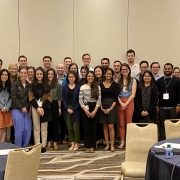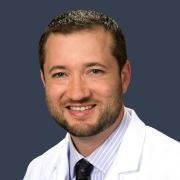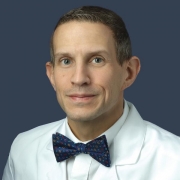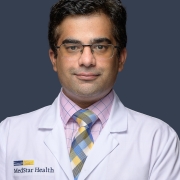People Profiles: Dr. Daniel Jamieson
/in News You Need to Know, People Profiles /by MedStar GME Admin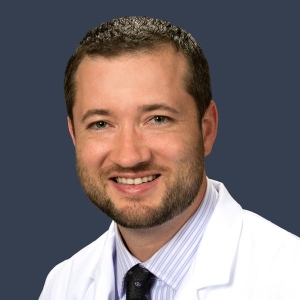
Dan Jamieson, MD (Pulmonary and Critical Care; Internal Medicine)
Dan Jamieson, MD (Pulmonary and Critical Care; Internal Medicine) has always called Maryland and the Washington, DC, area home – in fact he was born at Medstar Georgetown University Hospital! It’s no surprise then that after his fellowship, he ended up at MedStar Health, the largest healthcare provider in the region. Dr. Jamieson is the Program Director (PD) for the Pulmonary and Critical Care Fellowship at MedStar Georgetown University Hospital (MGUH) and one of the Associate Program Directors (APD) for Internal Medicine at MGUH.
Dr. Jamieson was inspired to pursue medicine while in high school when he developed a deep fascination with science and biology. His roles as a PD and APD at MedStar Health perfectly pair Dr. Jamieson’s medical skills as a clinician with his passion for mentoring and teaching the next generation of physicians.
“Number one will always be the students, residents and fellows,” Dr. Jamieson responded when asked what he enjoys most about working in graduate medical education. “There is an intentional focus on education in everything we do at Medstar Health. From our focus on the learning environment to the way we run daily rounds. I also love working with a dedicated team of educators to address current challenges in graduate medical education.”
There are always new challenges in healthcare, and MedStar Health is continually striving to find ways to build on current practices and better care for our patients and our communities. The knowledge that leaders like Dr. Jamieson are imparting on our residents and fellows are critical to that mission.
“The pace of change in medicine in the U.S. is impressive,” Dr. Jamieson said. “I know we will continue to support innovation and education of the next generation of learners.”
Dr. Jamieson doesn’t just envision a better future for healthcare – he is putting in the hard work to create that future. As one of three inaugural GME Leadership Fellows, Dr. Jamieson is gaining new insight into what it takes to run and improve our consortium and contributing his expertise to make it happen.
Dr. Jamieson and his wife have three children and they recently added two cats into the mix. “After intense negotiations with my daughter and wife, we have settled on Lola and Findus for their names,” Dr. Jamieson joked.
APPLY NOW: Academy for Emerging Leaders in Patient Safety
/in News You Need to Know /by MedStar GME AdminPeople Profiles: Dr. Christian Woods
/in News You Need to Know, People Profiles /by MedStar GME Admin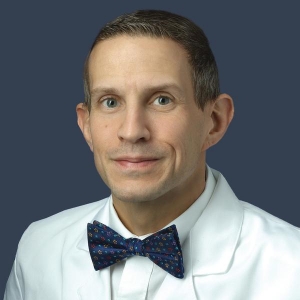
Christian Woods, MD (Pulmonary and Critical Care; Infectious Diseases)
When Christian Woods, MD (Pulmonary and Critical Care; Infectious Diseases) walked into Washington Hospital Center for his internship more than 20 years ago, he only intended to stay for a few years.
“My residency turned into a Chief Residency, which turned into fellowship one to fellowship two, and now I’ve been an attending physician since 2010,” Dr. Woods recalled.
In addition to being a double board-certified physician, Dr. Woods is the Program Director for the pulmonary and critical care medicine fellowship at MedStar Washington Hospital Center as well as an Associate Program Director for the internal medicine program. Dr. Woods deeply enjoys teaching and watching each resident or fellow’s individual journey.
“I learn just as much from my trainees, I think, as they learn from me,” he said. “I have a lot of pride watching them accomplish great things and become great physicians.”
Part of what makes a Program Director great, Dr. Woods believes, is having a personal investment in the success of your trainees and being willing to serve as a mentor. He experienced this first-hand as an intern when the esteemed Chair of Medicine at Washington Hospital Center at the time treated a young Dr. Woods as a respected physician, and not “just another resident.”
“I can give you the smartest doctor in the world to be your attending. But if the environment is not right, and you don’t feel comfortable and you don’t feel like you can inquire and ask questions, it’s a wasted opportunity,” Dr. Woods explained.
A lot of things have changed in the more than 20 years Dr. Woods has worked at MedStar Health, but GME and medical education has always remained a focus. “What’s unique about MedStar Health is that medical education and GME are so well regarded within our institution, and that makes it a great place to work.”
That’s why Dr. Woods is excited about the opportunity to further contribute to the success of MedStar Health GME as one of three inaugural GME Leadership Fellows. This unique fellowship is helping Dr. Woods expand his leadership capabilities while giving him new insight into what it takes to run a world-class medical education consortium.
As a student who became interested in the field of infectious disease after seeing how potent HIV medicines brought new hope to a devastating disease, and a physician who has experienced first-hand the challenges of providing evidence-based critical care in the face of a novel virus during the height of a COVID-19 pandemic, Dr. Woods knows that medicine is always changing. What he sees on the horizon for medicine is an expansion of global collaboration and education to better care for patients. For example, using synchronous training to teach to residents and fellows at MedStar Health – and around the country. Or using a telehealth platform to help a physician across the globe manage a ventilator console.
When Dr. Woods is not practicing medicine or teaching residents and fellows, he enjoys spending time with family. He also turned to building complicated Lego sets during the COVID-19 pandemic to relieve stress – a hobby that he has continued alongside his two sons. Next up on his Lego list? A 9,000-piece replica of the Titanic.
People Profiles: Dr. Tanmay Singh
/in News You Need to Know, People Profiles /by MedStar GME Admin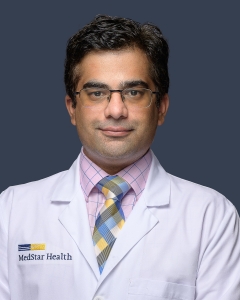
Tanmay Singh, MBBS (PGY-2, Internal Medicine)
“I have enjoyed my journey tremendously so far,” said Tanmay Singh, MBBS (PGY-2, Internal Medicine), when asked about his career in medicine.
Dr. Singh is an accomplished Internal Medicine resident at MedStar Health, and a representative on the Graduate Medical Education Committee (GMEC). But his journey in medicine started more than 7,500 miles away.
Dr. Singh grew up and attended medical school in Agra, India, home to the Taj Mahal, one of the Seven Wonders of the World. That’s also where he completed his first residency in Radiation Oncology. He decided to study medicine after watching physicians in his own family treat patients.
“I developed a very strong interest in health and causes of ill health, and trying to figure out the pathophysiology behind this was really intellectually rewarding,” Dr. Singh said.
Dr. Singh enjoys the puzzle presented by Internal Medicine, since no two patients are alike – even those who may share a diagnosis. “Delivering personalized care is the most enjoyable part of medicine for me. It’s a very dynamic process. There’s never a dull moment,” he said.
He also finds the environment at MedStar Health to be very conducive to learning. “The Attending Physicians are very intent on teaching and passing on their knowledge to the next generation. I think that kind of atmosphere is very incredible.”
Having already completed a residency, Dr. Singh knows how difficult it can be and one reason he chose MedStar Health is because of its dedicated focus on robust mental wellness.
“Residency comes with its own challenges, and I think feeling overwhelmed is pretty natural. Understanding how much mental health can impact the performance of residents and physicians is a big component of wellness. It’s awesome that the GME leadership realizes this and has put an incredible support system in place,” Dr. Singh said.
Dr. Singh urged his colleagues to take care of their own wellbeing by reaching out and asking for help so they can be the best physician possible. “People should not think that if they reach out for help, it’s going to reflect badly on them,” he explained. “There is help available, and it will make them better doctors by using the resources available to them.”
This willingness to step forward and help others makes Dr. Singh a natural fit for the GMEC. “I don’t hesitate – and wouldn’t hesitate – to raise issues into the knowledge of GME leadership. My philosophy is that is anybody has a concern they can come to me, and I will help bring those concerns to the forefront through the GME Committee,” he said.
Dr. Singh has found that the GME program promotes an open dialogue that lends itself to feedback and continual improvement. As Dr. Singh said: “We are good but can always be better.”
When Dr. Singh is not treating patients, he is working on his bucket list of visiting each of the 63 National Parks in the U.S. So far, he’s crossed off about a dozen of them, including Grand Canyon National Park and Acadia National Park. “My wife keeps saying that in an alternate world, I would have made a pretty good National Park ranger,” Dr. Singh joked.

At MedStar Health, we offer easy access to great health care in Maryland, Virginia, and Washington, D.C., via our 10 hospitals and more than 280 other care locations. We’re also committed to advancing patient care by continuously learning and applying new knowledge. About MedStarHealth

